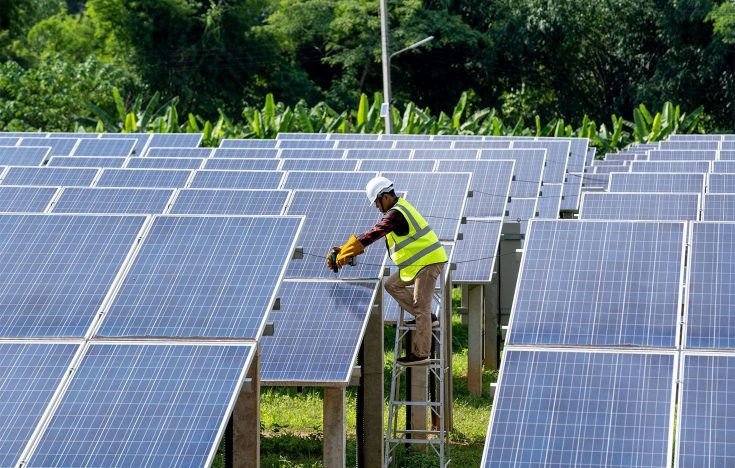The decarbonisation of the Asia Pacific (APAC) region will be critical in the global fight against climate change, accounting for more than 50% of the world’s carbon dioxide emissions in 2020. Discussions at COP26 in Glasgow this month produced a number of significant developments, including a joint pledge from China and the USA to accelerate efforts on climate co-operation. However, the conference has also highlighted the scale of the region’s challenge, and the massive investment required to reduce APAC’s reliance on fossil fuels. Asia’s institutional investors will need to rise to this challenge if the region is to curb its carbon emissions enough to limit temperature rises to below 2°C.

Asia is coming from a lower starting point, and that is all the more interesting because there is sometimes a market perception that investors in APAC are behind the curve. The APAC region is also the biggest enabler of a timely transition towards a low-carbon economy.
Paul Milon, Head of Stewardship, APAC, BNP Paribas Asset Management
So, what can Asian investors do to help the region catch up with the rest of the world?
BNP Paribas put that question to a panel of leading voices from major regional investors at this year’s Sustainable Future Forum. The discussion highlighted a number of key themes.
Sustainable investing improves returns
Investors in Asia are well-placed to benefit from the transition because companies with strong sustainability practices will deliver better risk-adjusted returns over the long term, said Rachel Teo, Head of the Futures Unit at Singapore sovereign wealth fund GIC. The relationship between sustainability and returns will only strengthen over time as markets more accurately price in the impact of carbon emissions and the risks associated with climate change.
“Investors can expect higher returns from investing in low-carbon businesses in Asia than in developed markets, purely due to the low starting point at which the region finds itself,” she said.
Climate change is key to investment decisions
This potential for higher returns will only be realised when investors take ownership of the challenge by integrating sustainability considerations into the investment process. That means closer engagement and financial support for companies transitioning to lower carbon business models. “That is a value creation process in itself,” said GIC’s Teo.
Carbon pricing is also gaining traction as a way to ensure that investors are aligning their portfolios with a 1.5°C or 2°C pathway. While discussions around global standards and tariffs are ongoing, Singapore’s Temasek this year set an internal metric to steer investment decisions.
“We have introduced an internal carbon price of US$42 per tonne,” said Frederick Teo, Managing Director for Sustainable Solutions, Temasek. “Looking ahead, we expect to increase the internal carbon price in tandem with our ambition to deliver on our carbon abatement targets… to help guide our investment decisions going forward.”
Physical risks need attention
The physical risks associated with climate change mean investors must focus on climate adaptation, not just mitigation. Better management strategies are needed, particularly in Asia where the number of mega cities is on the rise and the region is at risk from rising sea levels and heat.
“Investments that can address these problems should also contribute to climate change mitigation. For instance, more efficient urban and building designs to increase airflow, and the expansion of blue and green spaces will make cities more liveable and at the same time reduce the amount of energy and carbon emissions,” said GIC’s Teo.
Divestment is not the answer
The easiest way to decarbonise a portfolio is through divesting it of every heavy polluting company. But, as Temasek’s Teo explained, divestment alone does not solve the climate issue: “It basically passes the buck to somebody else.”
A more responsible approach comes from closer engagement with companies in the portfolio, setting them on a better decarbonisation trajectory that pivots them from a brown to a green strategy and helps them invest in cleaner energy solutions.
“It is much more helpful to work with our existing companies to set them on a better trajectory,” said Temasek’s Teo. “Otherwise we are not talking about a transformation of the economy or a transformation of our industries.”
Dr Mark Konyn, Group Chief Investment Officer, AIA, added to the case for engagement. “It’s all about understanding the risks to the business model,” he said. “It’s through engagement with the company that we can determine whether management has assessed risks from a climate perspective. And then we build that into our decisions.”
Financing drives change
According to the International Renewable Energy Association, as much as US$110 trillion invested in energy transition technologies around the world is required to reach the Paris climate targets. Governments alone cannot cover the bill, but they – along with International Financial Institutions, multilateral development banks, stock exchanges and industry associations – can help create the right environment for the development of innovative financial instruments needed to bridge the climate investment gap.
“IFC has evolved over the last few years to create new financing instruments that entice private sector participation in the green space,” said Lim Kim-See, Regional Director EAP, International Finance Corporation (IFC). She pointed to the concept of sustainability-linked bonds to help companies move up the green agenda. “It allows companies that are not green to start with accessing the capital markets to achieve green objectives.”
They are also accelerating capital flows into emerging markets and Asia. The World Bank Group, already the largest multilateral source of financing for climate change in developing markets, has increased its commitment with the launch of its Climate Change Action Plan 2021-2025. By July 2025, all new projects across the group will be 100% Paris-aligned.
The panel also added to calls for global standards and regulations to incentivise the private sector to invest at scale in new industries that target climate change, such as capital relief for financial institutions, global taxonomies and disclosure requirements.

